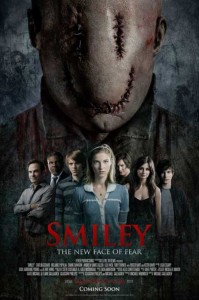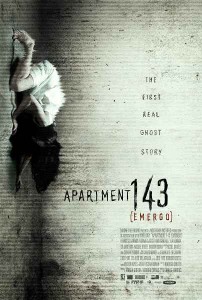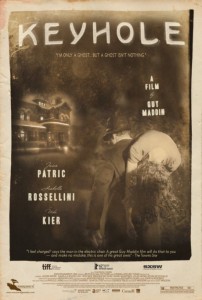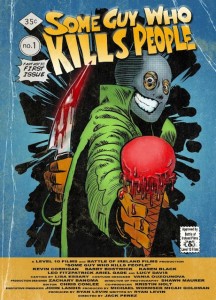
Smiley

Plot: The urban legend of Smiley states that, if you type “I did it for the lulz” three times on a video chat, Smiley (a serial killer who sewed his eyes shut and carved a smile on his face) will appear and kill your chat partner. Ashley (Caitlin Gerard) and Proxy (Melanie Papalia) test it out and discover the urban legend is real. Now, they’re worried that Smiley’s after them.
Review: You shouldn’t laugh at “Smiley” because it’s slightly based off of an internet emoticon. The idea behind an urban legend being real is truly frightening. It’s rarely done well in cinema (remember the “Urban Legend” films?), but always shows tremendous promise. With the rise of internet urban legends and a rather creepy looking villain, I held out hope for “Smiley”.
After viewing the film, I can safely say you can laugh at the film. Not because of the emoticon basis, but because it’s a terribly written slasher film that’s also disguised as a psychological thriller. Glasgow Phillips and Michael J. Gallagher (the latter of which directed) penned what has to be one of the most ludicrous and headache-inducing scripts I’ve seen put on screen in recent memory. With the exception of “Detention” and “Where the Dead Go to Die”, I can’t think of a worse script. Even those atrocities at least had some sort of originality and streamlined purpose going to them.
Want an example of the nonsensical writing on hand? As we learn, Smiley kills those who have the chant put upon them. They then go missing. Naturally, you’d think an investigation would occur (especially considering the murders are put on Youtube). The police believe this all to be a prank and, get this, have no evidence or know of the victim’s actual names (only online handles). For starters, you have the damn videos as evidence! Secondly, what about the victims’ friends and family who are reporting their missing person? One even posts about it on Youtube!
Gallagher does give a reason for this at the ending. The reason I’m not giving him credit for it is because it’s incredibly lazy and frustrating! I won’t spoil it for you fellow cinemasochists out there who want to check this out. All I’ll say is that it’ll have you screaming at your screen in anger! It’s the worst type of cop out ending!
As if the insipid writing wasn’t enough, Gallagher fills the screen with annoying caricatures. Ashley’s fine as a protagonist, but Caitlin Gerard’s performance is mediocre and there are times when she should be frightened and she comes across as bubbly. The psychological trauma and class discussions on ethics appear to develop her character, but only lead to cheap jump scares. Proxy is one of the most annoying sidekicks put on screen this year (possibly the past few years)! Everybody else is forgettable.
The only things saving “Smiley” from an ‘F’ is a good premise and a rather creepy looking villain. The Smiley character himself can send chills up one’s spine and does elicit what an internet urban legend would look like. Everything else about this film is atrocious!
Final Rating: D-
Apartment 143

Plot: A team of parapsychologists enter the home of the White family to investigate reports of strange occurrences that are believed to be paranormal.
Review: Carles Torrens has a lot going against him. The air of familiarity looms over “Apartment 143”. Found footage films, more specifically of the paranormal variety, are becoming very common in the horror genre. It seems one pops up every month now. It’s like the slasher craze of the eighties has transformed into the found footage craze of the current decade. Torrens has to do his damnedest to stand out from the pack.
I’ll give Torrens credit; he does a fine job of standing out! Working off of a script by Rodrigo Cortés (who directed “Buried” and “Red Lights”), he examines a different type of paranormal phenomena. It’s explained as a poltergeist that manifests due to one’s rage and guilt. The psychological explanation speaks on deaf ears. All the viewer wants to see are the haunting results.
Torrens delivers the goods. He works off of the formula created by films such as “Paranormal Activity”. The parapsychologists set cameras up throughout the apartment and carry around cameras to film interviews and activity. We have scenes where the tension comes from simply scanning the room and waiting for something to happen. Since we soon learn that most of the activity arrives via negative energy, there’s not many of these. We get a hefty amount of gigantic damage caused by violent paranormal activity to make up for that.
While some of the revelations detailed by the doctor fall on deaf ears, the interaction between the White family doesn’t. The more we learn about their past and the actual cause of the mother’s death explains why the activity has followed them to this apartment. It also explains why it’s so violent and adds depth not only to the characters, but the activity as well. For films such as “Paranormal Activity”, the fear is in not knowing why the activity is happening (which I’ll admit I prefer). Torrens bucks that trend, but makes the reasoning chilling enough that it doesn’t dampen the mood.
“Apartment 143” swims in a sea full of familiar content. While there are moments where it blends in with them, the human emotions and different take on the activity helps it stand out. Torrens shows determination and stubbornness (a good trait this time around) that keeps the events tightly wound. If you’re still craving some found footage ghost thrills, this is a good way to quench that.
Final Rating: B
Keyhole

Plot: Ulysses Pick (Jason Patric) rounds up his group of gangsters in his childhood home during a shootout with the police. As the night wears on, he goes through an unusual and spiritual journey through the labyrinthine house.
Review: This was my first exposure to Guy Maddin’s work. I’ve heard positive things about him from quite a few film fans. After watching “Keyhole”, I can see why he’s gathered a following. His films are complex, gorgeously shot and have passion behind them. This doesn’t always equal intrigue for the viewer. The hardest thing about being a film critic is reporting when a film bores you.
With “Keyhole”, I found the performances and technical aspects to be perfectly fine. The cinematography was great, as was the film noir look and feel (the film is presented in black and white). Jason Patric was good as Ulysses Pick (though I kept imagining Guy Pearce in the role), as were Isabella Rossellini and Udo Kier in their supporting roles. I even liked the effort put into the story, which reminded me of Alfred Hitchcock at times (with a lot more nudity and depravity, mind you).
Yet, I couldn’t become engaged in the film. As the story progressed, the harder I struggled to pay attention. The twists and turns weren’t clicking with me. I felt the film’s length slowly tick away with each new entry into the house. I wanted to like the film, but couldn’t muster any reason to care. Is this faulty filmmaking on Guy Maddin’s part?
The only aspect of this film that I felt was faulty filmmaking was the tone. It’s never quite clear if this is meant to be a drama or a thriller. The two can easily be mixed, but Maddin doesn’t gel them together well. It’s more clear which tone the film takes near the end, but it’s too little too late by then. Maybe if the tone were ironed out more, I would have liked this film more. There’s also the possibility that I still would have been bored. I can tell that Guy Maddin is a talented filmmaker. This just isn’t the film of his to be introduced to.
Final Rating: C
Some Guy Who Kills People

Plot: Ken Boyd (Kevin Corrigan) is a depressed man who’s just been released from a mental institution. His friend hooks him up with a job at an ice cream parlor, where he minds his business. He lives a quiet life with his mother, Ruth (Karen Black), until his daughter, Amy (Ariel Gade), arrives at his house. He tries to be a good father, but his mysterious past gets in the way, as does a wave of murders that he may be connected to.
Review: I’d like to see the version of “Some Guy Who Kills People” that worked. I’m sure there’s one out there. It could have been a lightweight comedy. Possibly a straight-laced horror tale. Maybe even a quaint little drama. For all we know, it’s possible all three could have been mixed into together to make a sweet little film. Jack Perez was hoping for the latter, but his disjointed direction didn’t make that possible.
I could blame Ryan A. Levin’s script instead. I haven’t read his draft, which could have been changed drastically, so I’m holding back my criticism. I’d like to think it was, as the ridiculous twist at the end leaves too many plot holes upon. Perez does his best to cover them up, but I feel it was his idea with the finale. A happier ending, of sorts. If it was indeed in Levin’s script, I’ll still blame Perez for not fixing such a large error in storytelling.
The cast themselves give hearty performances, doing their best to steer the bumpy material onto a paved road. Kevin Corrigan, the most underrated and underutilized actors working today (despite appearing in films from notorious directors such as Martin Scorsese and Ridley Scott, to name a few), turns in a fine performance as Ken. He’s a likable guy and his performance almost makes the twist work because of this. Karen Black, despite apparently phoning in her performance, is devilishly good as his despondent mother. Lucy Davis is lovely as Stephanie, Ken’s love interest. Barry Bostwick even gets a few laughs as the Sheriff, despite his characteristics seeming heavily out of place. The true surprise in the cast is Ariel Gade, whose perky performance as Amy never annoys the audience (a hard feat for any child actor). Her dialogue and character tiptoes on the line, but she keeps her balance and, like Kevin’s performance, almost makes the twist work.
That word keeps popping up; almost. A lot of things in “Some Guy Who Kills People” almost work. The humor almost works. The drama almost works. The thrills… well, they’re nonexistent. The performances are so strong that they almost make this work. The reason this film doesn’t work is because Perez never finds a concrete tone. He shifts back and forth between comedy, drama and horror, never settling on one. He wants his cake and to eat it too. His overzealous direction, as well as a twist ending that shoots itself in the foot, leaves the viewer unsatisfied.
Final Rating: C
